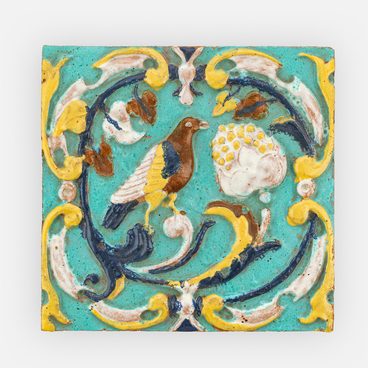The exhibition presents a square-shaped polychrome relief tile. It is a modern replica, stylized as a product of the 17th–18th centuries. The tile is decorated with a convex vegetal pattern: in the center there is a white rosette with six carved leaves, each leaf adorned with a green triangle and a blue outline. The central flower has six rounded leaves in yellow and green, with a blue “knop” in the center. The rosette is framed by a convex frame of vegetal design with inward-pointing scrolls and two small yellow leaves, with two white “knops” on both sides outside the frame. The rumpa box-shaped compartment has one small through hole on each side, it is set at a margin from the edges. A wire is usually threaded through small holes in a rumpa in order to attach the tile to the masonry of a wall or stove.
In the 17th century, craftsmen started to produce glazed tiles with a coating on the top. Tiles in the form of plates and columns came into use. At first the reliefs were covered with transparent glaze — murava. Later, they began to decorate the products with opaque tin glaze of different colors — tsenina (majolica). Original tiles were produced in Moscow, Veliky Ustyug, Vologda, Kaluga, Balakhna and other places.
In the 18th century, Peter the Great sent Russian craftsmen to Delft to learn the “tile business” — and smooth tiles of the “Dutch tile” type appeared. They were painted: the tiles were covered with white enamel and blue cobalt paints were used to draw canals, ships, and mills. The tsar forbade heating houses “in the black way” with a stove venting into the room, and the new type of stoves became known as Dutch stoves by their tiles. Smooth tiles were mass-produced at the factory of Alexander Menshikov in Strelna near St. Petersburg and at the tile factory of Afanasy Grebenshchikov in Moscow.
The palette of colored enamels and the technique of
painting became more diverse, resulting in “picturesque paintings” on tiles. In
the 19th century, ceramic production was an industrialized process, for
example, in Matvey Kuznetsov’s “Partnership”. The tiles looked less and less
like piece goods. However, unique decorations from the end of the century have
survived — in Maria Tenisheva’s Talashkino estate or Savva Mamontov’s
Abramtsevo.

